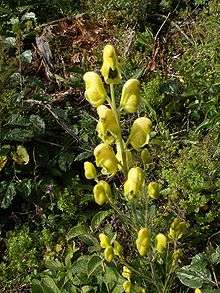Aconitum anthora
| Yellow Monkshood | |
|---|---|
 | |
| Scientific classification | |
| Kingdom: | Plantae |
| (unranked): | Angiosperms |
| (unranked): | Eudicots |
| Order: | Ranunculales |
| Family: | Ranunculaceae |
| Genus: | Aconitum |
| Species: | A. anthora |
| Binomial name | |
| Aconitum anthora L. | |
Aconitum anthora, variously known as anthora, yellow monkshood, or healing wolfsbane, is a yellow flowering plant species of the genus Aconitum in the family Ranunculaceae.
Its native range is widespread, but mainly in European mountains, such as the Alps and the Carpathians, and the northern parts of Asia. Like all Aconitum species, it has great variability, due to isolation and hybridisation. Because of this polymorphism, A. anthora is included in the Aconitum vulparia group. It flowers from July to September.
Historically, its root, which is tuberous, was reputed to be a good antidote, and a counter-poison to poisons from 'thora'[1] or Aconitum pardalianches, whence its naming anthora or "against thora". This plant is extremely toxic to livestock and humans. Even small doses can be deadly.
The root contains a large amount of volatile salt and essential oil, while the foliage and stems contain diterpenoid alkaloids. It has been used externally against rheumatism and deep pain, but it can irritate the skin. Internally, it has been used for weak pulse, vegetable poisons (shoot), feverish colds, pneumonia, croup, heart conditions, and cardiac arrest.
Synonyms
- Aconitum pseudanthora Blocki ex Pacz.
- Aconitum eulophum Rchb.
- Aconitum jacquinii Rchb.
- Aconitum nemorosum M.Bieb.
References
- "Aconitum anthora". Herbal Harmony's Directory. Retrieved 2006-01-16.
 This article incorporates text from a publication now in the public domain: Chambers, Ephraim, ed. (1728). "article name needed". Cyclopædia, or an Universal Dictionary of Arts and Sciences (first ed.). James and John Knapton, et al.
This article incorporates text from a publication now in the public domain: Chambers, Ephraim, ed. (1728). "article name needed". Cyclopædia, or an Universal Dictionary of Arts and Sciences (first ed.). James and John Knapton, et al.
External links
- Aconitum anthora in Topwalks
- Has illustration of the acontium by Maund, B., The botanic garden, t. 169-192, vol. 8: t. 174, fig. 3 (1839-1840)